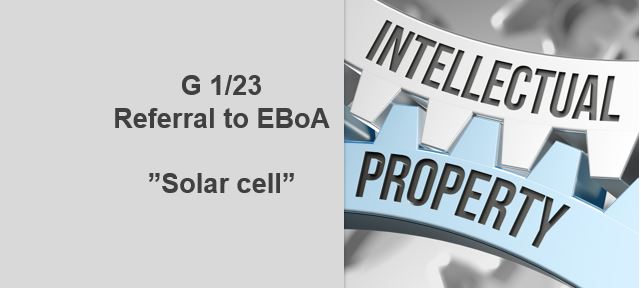Referral G 1/23 – Which parts of a disclosure belong to the prior art?

- Tiia-Riikka Kittilä
- –
- News
- –
- 1.8.2023

An invention is compared to known technologies when assessing its patentability. The invention must be novel, meaning that it differs from known solutions by at least one feature. In addition, the invention must be inventive, meaning that it should not be obvious to a person skilled in the art. For example, a product placed on the market can prevent patenting even if the product has not been described in writing.
In the field of chemistry, this can lead to a peculiar situation where the composition is available, but the different components of the composition and their concentrations cannot be deduced without a detailed analysis of the product. The question is whether such composition has become known after the product has been placed on the market.
When drafting the European Patent Convention it was considered that, an invention is disclosed if, by virtue of the disclosure, a person skilled in the art could carry out the invention. Decision G 1/92 further specified that the invention has become known if a person skilled in the art is able to analyse and reproduce the invention without undue burden on the basis of the prior disclosures.
However, the requirement to analyse and reproduce an invention without undue burden is ambiguous and has led to different interpretations in different contexts. A new referral to the Enlarged Board of Appeal of the European Patent Office, G1/23, has therefore been submitted based on decision T 0438/19 of a Technical Board of Appeal. The referral asks for clarification on three issues, in particular with respect to chemical compositions, in order to unify practices.
1. Does the product or the composition of the product belong to the prior art?
The first question concerns a situation where a product does not belong to the prior art, because it cannot be analysed or reproduced. In this case, it may be interpreted that the product itself is not part of the prior art, or alternatively that the chemical composition or the internal structure of the product is not known, even though the product itself is known.
The question may seem theoretical, but in practice, problems can arise, for example, when assessing inventive step. If the product itself is not part of the prior art, then a skilled person could not have developed it further. In this case, it is reasonable that the product cannot be used to assess the inventive step of another product.
However, if the product was available, a skilled person could have used it as a starting point for a new invention, even if they could not exactly analyse or reproduce the product. This is especially true if the intended use of the product and its advantages have been disclosed, in which case a person skilled in the art might find the product interesting because of its features. Of course, in these situations it would be natural that a small change in the product would not be sufficient to obtain a patent, even if the exact composition of the product is not known. It may therefore be appropriate to consider that the product has become known, but its composition or internal structure has not
2. What does it mean to reproduce a product?
In some situations, an invention may be obvious, even though it cannot be reproduced identically. Should the invention then be considered to have become public or not?
For example, one might consider a situation where the invention is a caramel-colored fizzy drink. It is obvious that Coca-Cola fits the description, but the recipe for Coca-Cola is not known, and a person skilled in the art cannot make an identical copy. Would the invention be novel or not?
Further, some chemical compositions can be very complex, and it can be very difficult to accurately determine their structure and reproduce the product. For example, synthetic polymers comprise similar units linked together in a complex structure. Different polymers may contain same units that are simply organised in different ways. Therefore, such structures are usually described by their properties.
If the reproduction of a composition means making an identical copy, then, for complex compositions, the question arises how to define that a composition is or is not identical when there is no single way to define the composition.
Further, since the decision G 1/92 explicitly states that the principles of analysis and reproduction should be applied to all products, a clarification is also needed for mechanical and electrical inventions. Does the requirement of reproduction concern a part of a product or the entire product? To what extent should the product be reproduced? Must one be able to also analyse the chemical composition of various components? In particular, do the principles of analysis and reproduction also apply to those parts of the product that are irrelevant to the assessment of inventive step?
2. Are partial descriptions of the structure of the product or its characteristics part of the prior art?
Often, various marketing materials or technical brochures refer to the features and benefits of a product without providing any details. Obviously, such materials do not permit reproduction of the product, and the question then arises as to whether the published features are prior art.
In the case of the polymers mentioned above, the requirement of reproduction would mean that the way these products are described does not make them or their properties part of the prior art. However, the properties described may be sufficient for a person skilled in the art to use in developing new technologies. In these situations, it would seem appropriate for the disclosed features to be part of the prior art even though they do not enable the product to be reproduced.
The questions of the referral are:
- Is a product put on the market before the date of filing of a European patent application to be excluded from the state of the art within the meaning of Article 54(2) EPC for the sole reason that its composition or internal structure could not be analysed and reproduced without undue burden by the skilled person before that date?
- If the answer to question 1 is no, is technical information about said product which was made available to the public before the filing date (e.g. by publication of technical brochure, non-patent or patent literature) state of the art within the meaning of Article 54(2) EPC, irrespective of whether the composition or internal structure of the product could be analysed and reproduced without undue burden by the skilled person before that date?
- If the answer to question 1 is yes or the answer to question 2 is no, which criteria are to be applied in order to determine whether or not the composition or internal structure of the product could be analysed and reproduced without undue burden within the meaning of opinion G 1/92? In particular, is it required that the composition and internal structure of the product be fully analysable and identically reproducible?
Read more here.

